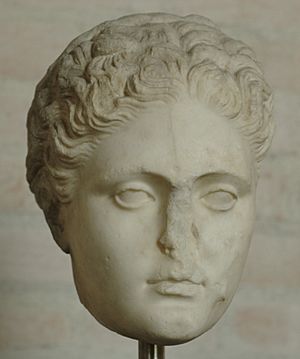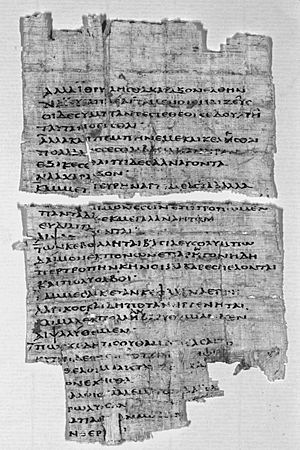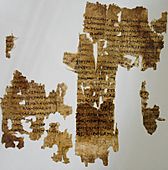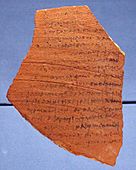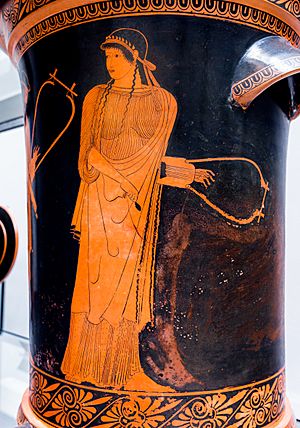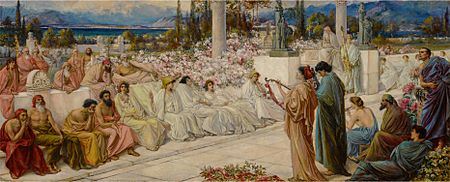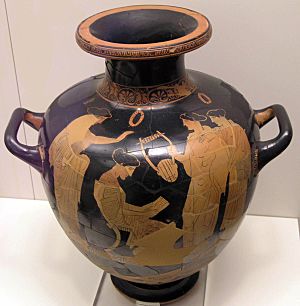Sappho facts for kids
Sappho (pronounced SAFF-oh) was an ancient Greek poet. She lived around 630 to 570 BC. Sappho came from the island of Lesbos. She was famous for her lyric poetry. This type of poetry was meant to be sung with music.
In ancient times, many people thought Sappho was one of the greatest poets. They even called her the "Tenth Muse." A Muse was a goddess of art and inspiration. Sadly, most of Sappho's poems are now lost. Only one complete poem, the "Ode to Aphrodite," still exists. Many other poems are just small pieces or fragments.
Not much is known about Sappho's life for sure. She came from a rich family on Lesbos. She had three brothers named Charaxos, Larichos, and Eurygios. Some ancient writings say she was sent away to Sicily around 600 BC. She might have kept writing poetry until about 570 BC.
Sappho wrote a lot of poetry, perhaps 10,000 lines. She was best known for poems about feelings and relationships. Her surviving works also talk about family and religion. She wrote poems for both single singers and groups. Her poems are known for their clear words and strong images. They feel very immediate and real.
Sappho's poetry was very popular for a long time. Scholars in ancient Alexandria thought she was one of the top nine lyric poets. Her works still inspire writers today.
Contents
Learning About Sappho
We learn about Sappho from two main sources. One is her own poetry, though most of it is in pieces. The other source is what other ancient writers said about her. The oldest complete story about Sappho was written about 800 years after she lived. Another important source is the Suda. This is a large encyclopedia from the 900s AD.
Some details about her life came from her own poems. Ancient writers thought these poems were about Sappho herself. Other stories came from local traditions. Some ideas about her, like how she looked, might have come from ancient plays.
For a long time, people believed these old stories about poets. But in the 1800s, scholars started to question them. They tried to find facts in the poets' own works. Later, in the 1900s, some scholars became even more careful. They wondered if the "I" in a poem always meant the poet. Most experts today think ancient stories have some truth. But they also say we must be careful when reading them.
Sappho's Life Story
We don't know many facts about Sappho's life. She lived on the island of Lesbos. This was at the end of the 600s BC and the start of the 500s BC. Most ancient sources agree on these dates. They say she lived at the same time as other poets from Lesbos.
Some experts think she was born around 650 or 640 BC. Others suggest it was around 630 BC or earlier. She may have continued writing until about 570 BC.
Tradition says Sappho's mother was Cleïs. This name might come from a lost poem. Or, ancient scholars might have guessed it. They may have thought Sappho's daughter was named after her mother. Ancient sources list ten different names for her father. This means his name was probably not in her poems. The most common name for him is Scamandronymus. One story says her father died when she was six.
Sappho had three brothers: Eurygios, Larichos, and Charaxos. An ancient writer said she praised Larichos. He was a cupbearer in Mytilene's town hall. This job was for boys from the best families. This suggests Sappho came from a noble family. One story says her brother Charaxos spent a lot of money on a woman named Rhodopis. Sappho supposedly wrote a poem criticizing him. Two brothers, Charaxos and Larichos, are in a poem found in 2014.
Sappho might have had a daughter named Cleïs. She is mentioned in two poem fragments. Not all scholars agree that Cleïs was her daughter.
The Suda says Sappho married a man named Kerkylas from Andros.
One story says Sappho was sent away from Lesbos around 600 BC. This might have happened because her family was involved in political fights. We don't know which side her family supported. But many scholars think they were with the same group as the poet Alcaeus. He was also sent away when Myrsilus took power.
Sappho's Writings
Sappho likely wrote about 10,000 lines of poetry. Today, only about 650 lines still exist. She is most famous for her lyric poetry. This poetry was written to be sung with music. The Suda also says she wrote other types of poems. These include epigrams and elegiacs. Three epigrams exist, but they are later poems inspired by Sappho.
Ancient writers said she mainly wrote poems about feelings and relationships. The surviving pieces of her work support this idea. However, new papyrus discoveries suggest this might not be entirely true. A group of papyri found in 2014 has ten poems. Only two are clearly about love. At least three, and maybe four, are mostly about family.
Old Collections of Her Poems
We don't know when Sappho's poems were first written down. Some scholars think she wrote them down for future readers. Others believe she wrote them to help her perform them again. In the 400s BC, Athenian publishers started making copies of Lesbian lyric poetry. These copies sometimes included notes and explanations.
Around the 200s or 100s BC, scholars in Alexandria created a special edition of her poetry. This edition might have been based on texts from Athens or Lesbos. It was divided into at least eight books. Many modern scholars think there was a ninth book too. The Alexandrian edition probably grouped her poems by their rhythm. The first three books had poems with a specific rhythm. Book one, with poems in Sapphic stanzas, was likely ordered alphabetically.
Even after this standard edition, Sappho's poems were in other collections. For example, the papyrus with the "Tithonus poem" was part of an anthology. This collection arranged poems by theme, not by rhythm.
Surviving Poems Today
The oldest surviving pieces of Sappho's poems are from the 200s BC. These include a piece of pottery with fragment 2. The latest copies are on parchment pages from the 500s and 600s AD. These were copied from older papyrus scrolls. Copies of her work might have lasted a few more centuries. But by the 800s AD, her poetry seemed to disappear. By the 1100s, a writer said that time had destroyed Sappho's works.
Some legends say Sappho's poetry was lost because the church didn't approve of her. These stories started in the 1500s. For example, one story says a church leader ordered her work to be burned.
In truth, Sappho's work was probably lost because not enough people wanted to copy it. Books changed from papyrus scrolls to parchment books. Her poems were also written in a special Greek dialect. This dialect was seen as old-fashioned. Many readers found it hard to understand. This was part of a general decline in interest in very old poets. Still, Sappho's poetry seems to have lasted longer than that of her friends.
Only about 650 lines of Sappho's poetry remain. Just one poem, the "Ode to Aphrodite," is complete. About ten more fragments have more than half of their original lines. Many fragments are just a single word. For example, fragment 169A is only the word "wedding gifts." It survived because it was in a dictionary of rare words.
The two main ways Sappho's fragments survived are:
- Quotations in other ancient books. These can be a whole poem or just one word.
- Pieces of papyrus, many found in Oxyrhynchus, Egypt.
Other fragments are on parchment or broken pottery. The oldest known fragment is the Cologne papyrus. It has the "Tithonus poem" and is from the 200s BC.
Until the late 1800s, we only knew Sappho's poetry from quotes. In 1879, the first new fragment was found in Fayum. Later, at Oxyrhynchus, many more unknown fragments were found. New fragments of Sappho are still being discovered. In the 2000s, big finds happened in 2004 and 2014. The 2014 find included the "Brothers Poem." In 2005, a commentary on her poems was published.
Sappho's Poetic Style
Sappho wrote in a well-developed poetic style from Lesbos. This style had its own words, rhythms, and rules. Before Sappho, Lesbos was known for poetry and music. This was thanks to mythical figures like Orpheus. The rhythm style she used was different from other parts of Greece. Her lines always had a set number of syllables.
Sappho was one of the first Greek poets to use the "lyric 'I'." This means she wrote poems from the view of a specific person. Earlier poets like Homer presented themselves as inspired by gods. Sappho's poetry explores personal feelings. These include desire, jealousy, and affection. She also used ideas from older epic poems. Much of her poetry focuses on the lives of women. Besides her famous poems about feelings, she wrote about family. She also wrote wedding songs and hymns to gods.
Scholars disagree on how Sappho's poems were performed. They seem to have been for different events, both public and private. They likely included songs for solo singers and for groups. Most of her best-preserved fragments, like the "Ode to Aphrodite," were probably for solo performance. These poems often avoid specific times or places. This made it easier for others to perform them later.
Sappho's poetry is known for its clear language. It has simple ideas and sharp images. She often used direct quotes, which made her poems feel immediate. She also liked to play with words. For example, in fragment 96, she says: "now she stands out among Lydian women as after sunset the rose-fingered moon exceeds all stars." This is a twist on an old phrase for the dawn. She also used exaggeration. In fragment 111, she writes that "The groom approaches like Ares [...] Much bigger than a big man."
Sappho's poetry often showed a love for fine things and noble birth. She connected her world to Greek myths, gods, and heroes. She also linked it to the rich East, especially Lydia. In fragment 2, Aphrodite pours "nectar lavishly mingled with joys" into golden cups. In the "Tithonus poem," she says, "I love the finer things." Her language and content showed an aristocratic world.
Music in Sappho's Poems
Sappho's poems were meant to be sung. But we don't know much about their music. It's unlikely that ancient Greece had a system for writing music before the 400s BC. So, the original music for her songs probably didn't survive. No ancient musical notes for her poems exist today.
Sappho reportedly wrote in the Mixolydian mode. This was a musical scale that sounded sad. It was used in Greek tragedies. Some believed Sappho invented this mode, but that's probably not true. She likely used different modes depending on the poem's mood. When sung, each word probably had one note.
Sappho wrote songs for both solo singers and choirs. With Alcaeus, she started a new style of solo singing. This was different from the group singing that was common before. This new style let her make her poems more personal. A historian named Plutarch said she "speaks words mingled truly with fire." Some scholars think the "Tithonus poem" was for a solo singer.
Only parts of Sappho's choral works still exist. Her wedding songs survived better than her hymns to gods. These hymns were probably sung by two groups. Or, they might have been sung by a soloist and a choir.
In Sappho's time, sung poetry usually had musical instruments. These instruments often played the same tune as the voice. Sappho's poems mention several instruments. These include the pektis, a type of harp, and the lyre. Sappho is most linked to the barbitos. This was a string instrument like a lyre, with a deep sound. An ancient writer said she mentioned it in her poetry. An old vase painting shows Sappho and Alcaeus with barbitoi. Sappho also mentions the aulos, a wind instrument, in fragment 44. It was used at Hector and Andromache's wedding. Later Greek writers wrongly thought she invented the plectrum.
How Sappho's Poems Were Used
Scholars have spent a lot of time trying to figure out how Sappho's poems were used. They have suggested different roles for her. These include teacher, priestess, and leader of a chorus. However, it's hard to know for sure how many of her poems were performed. Many poems could fit more than one idea.
One old idea is that Sappho was a schoolmistress. This idea was popular in the 1800s and early 1900s. It was used to explain her strong feelings for her "girls." It also tried to defend her from certain accusations. More recently, historians have said this idea doesn't fit the time period. Many experts now say there's no real proof for it. For example, one scholar said in 1959 that her poems show "the loves and jealousies, the pleasures and pains, of Sappho and her companions." He added, "We have found... no trace of any formal or official or professional relationship." Sappho's own poems don't mention her teaching. The first source to say she was a teacher came 600 years after she lived.
So you hate me now, Atthis, and
Turn towards Andromeda.
— Sappho 131, translated by Edward Storer
In the late 1900s, scholars started to think Sappho helped educate girls for rituals. For example, she might have trained girl choruses. Not all her poems fit this idea. But some scholars think it's the most likely setting for her work. Another idea was that Sappho was a priestess of Aphrodite. She did write hymns to Aphrodite. But there's no proof she was a priestess.
More recent scholars have suggested Sappho was part of a group of women. These women might have met for special gatherings. Sappho would have written and performed poetry for them. Or, she might have written poems for men's gatherings. Her songs were certainly performed at such gatherings later. But there's no outside proof of women's gatherings in ancient Greece. Even if some poems were for these events, it's unlikely her hymns or family poems were.
One scholar argues that there isn't one single way all of Sappho's poems were used. Another scholar agrees. He suggests she could have written poems for teaching. She also could have written them for a group of friends.
Sappho's Lasting Impact
Her Fame in Ancient Times
In ancient times, Sappho's poetry was greatly admired. Several ancient writers called her the "tenth Muse." This idea appeared in a poem from the 200s BC. Other poems also shared this theme. She was sometimes called "The Poetess." This was like how Homer was called "The Poet." Scholars in Alexandria included her in the list of nine great lyric poets.
One story says that Solon, a famous Athenian lawmaker, asked to learn a song by Sappho. He supposedly said, "so that I may learn it and then die." This story might not be true. But it shows how highly Sappho's poetry was thought of.
Sappho's poetry also influenced other ancient writers. Plato mentioned Sappho in one of his writings. His ideas about love seem to be like Sappho's descriptions of how desire affects the body. Many poets in the Hellenistic period used or changed Sappho's works. The poet Nossis was seen as someone who copied Sappho's style. She wanted to be seen as a female poet like Sappho. Several of Theocritus's poems refer to Sappho. This includes one that copies her language and rhythm. Poems by Erinna and Callimachus also had themes like Sappho's. They were about separation.
In the 1st century BC, the Roman poet Catullus brought Sappho's themes and rhythms to Latin literature. He used the Sapphic stanza, which was thought to be invented by Sappho. He called his lover in his poems "Lesbia," referring to Sappho. He also adapted Sappho's fragment 31 in his poem 51. Fragment 31 was often mentioned in Latin literature. Other Latin poets also referred to her poems.
Other ancient poets wrote about Sappho's life. She was a popular character in ancient Athenian comedies. At least six different comedies were called Sappho. We only have pieces of these plays. So, we don't know exactly how they showed Sappho. Sappho was also a favorite subject in art. She was the most common poet shown on red-figure vase paintings in the 500s and 400s BC. She was also on coins from Mytilene and Eresos. She was reportedly shown in sculptures and paintings.
While Sappho's poetry was admired, her character was not always seen well. In the Roman period, some critics thought she was too passionate. By the 200s AD, people started to think there might have been two Sapphos. This was because her fame as a poet was so different from her reputation as a woman.
See also
 In Spanish: Safo de Mitilene para niños
In Spanish: Safo de Mitilene para niños
- Ancient Greek literature



